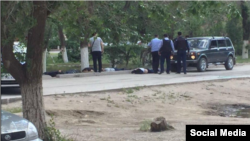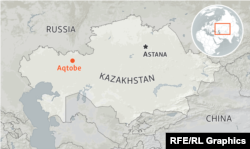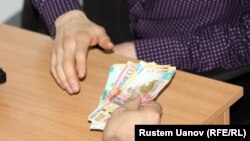
The June 5 violence in Kazakhstan's northwestern city of Aqtobe was surprising. Such incidents don't usually happen in Kazakhstan.
But on those rare occasions when they do, it seems like it's in western Kazakhstan, or more specifically, the Aqtobe area.
Kazakh officials were scrambling on June 6 to explain who was behind the shooting that had left at least 18 people dead, at latest count, including 12 of the attackers, or why they'd done it.
But the explanation might be staring them in the face.
Aqtobe, with a population of around 400,000, is located in Kazakhstan's western oil region. Oil sales have driven Kazakhstan's economic success for years (or at least they had until the recent drop in world oil prices), but little of that money has trickled down to the major oil cities of western Kazakhstan, Aqtobe among them.
Meanwhile, billions of dollars have been spent building up the capital, Astana, and the commercial capital, Almaty.
So there is general discontent over state neglect of the social conditions in western Kazakhstan in general, and especially in Aqtobe. To make matters worse, western Kazakhstan has been portrayed as a region where Islam has deeply rooted itself since the collapse of the Soviet Union in late 1991 -- leading Kazakh officials to ascribe acts of violence to Islamic extremists or their influence and giving parts of western Kazakhstan an image many residents feel it doesn't deserve.
Aqtobe has the dubious distinction of being the only place in Kazakhstan where a suicide bomber has staged an attack. That happened on May 17, 2011, when 25-year-old Rahimjan Makhatov walked into a regional branch of the National Security Committee and detonated his explosives, killing himself and injuring two other people. Kazakh authorities were quick to claim that Makhatov had connections to Islamic extremists, but there was never much proof available publicly.
Some Kazakh officials have already linked the June 5 attacks in Aqtobe to "nontraditional" religious groups, a term that usually denotes Islamic extremists. At this early stage, there is no publicly available evidence of such a connection. But it would not mark the first time Kazakh officials have linked unrest in western Kazakhstan to Islamic extremism.
Following Makhatov's 2011 suicide bombing, Kazakh media reported the existence of Salafi communities in western Kazakhstan, villages with young bearded men who were extremely pious and, the reports hinted, potentially dangerous.
When two policemen were killed in late June 2011 in a village some 200 kilometers south of Aqtobe, authorities sent elite forces to the area. During the ensuing operation, nine suspects and one policeman were killed. The initial official suggestion that the group was influenced by Islamic extremism eventually evolved to claiming the suspects were members of a criminal organization operating under the guise of religion.
A bit farther away, there was also the so-called Jund al-Khilafah (Soldiers of the Caliphate) terrorist group founded by three Kazakh citizens from Kazakhstan's Caspian Sea port city of Atyrau, around 500 kilometers southwest of Aqtobe. That group claimed responsibility for two bombings in Atyrau in November 2011 and for an attack days later in Almaty, in which five militants and two policemen were killed.
Though Kazakh authorities claimed that Jund al-Khilafah had links to Pakistan's tribal region, the three founders of the group were all later found and arrested in Kazakhstan.
Kazakhstan's western regions have proven to be the most restive in the country in the last half decade. There was also the six-month strike by oil workers in Zhanaozen that ended with at least 15 people being killed when police opened fire on demonstrators on Kazakhstan's Independence Day on December 16, 2011.
So if violence was going to happen, it is perhaps unsurprising that it struck in western Kazakhstan. Nor is it a surprise that investigators are having a hard time establishing a motive for the June 5 attacks.
But as much as many officials in the Kazakh government would like to believe this latest violence was inspired, or even planned, by forces outside the country, the reasons are probably easy to see in the everyday lives of residents of western Kazakhstan.









